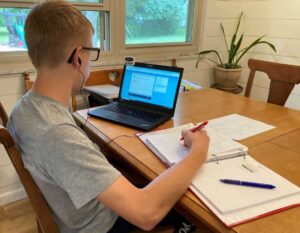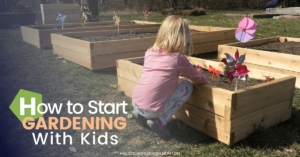Poetry teatime is a highly anticipated event in our homeschool every Thursday. It’s a fantastic addition to any homeschool, and has proven to be invaluable in ours. I have five simple tips for how to start a poetry teatime in your homeschool.
I wish I could tell you that poetry teatime has been part of our homeschool since the very beginning, but I’d be lying. Truth be told, this is only our second year!
While having an afternoon tea is a common practice in many cultures, it’s definitely not common practice in the United States.
I never grew up drinking much tea (except for iced tea in the summer), and with the exception of a few Shel Silverstein books, have always felt rather uncomfortable around poetry…until we started incorporating more poetry into our homeschool.
Enter poetry teatime!

What is Poetry Teatime?
The idea is quite common in homeschool circles, and has gained popularity through the writings of Julie Bogart of Brave Writer.
She notes: “Poetry teatime offers you and your children a break from the fast-paced demands of homeschooling, parenting, and household running. Everyone sighs a collective “ahhhh” as they settle into their chairs, tea cups or mugs in hand, poetry books scattered across the table.”
Her statement has been 100% absolutely true in our homeschool.
My kids look forward to this event every Thursday afternoon. I will admit they are highly enticed by the yummy treats that accompany the occasion, but we truly have a great bit of fun during this time.
Why Include Poetry Teatime in Your Homeschool?
The best reason for including poetry teatime in your homeschool is that you will be exposing your children to excellent poetry in a relaxed and enjoyable setting. This will set an excellent and fertile foundation to plant seeds of love for poetry.
Ultimately, by establishing an enjoyable relationship with poetry now, I hope my kids will not be as apprehensive of poetry as I was in my educational journey.
I vividly remember borrowing Shel Silverstein’s poetry book, Where the Sidewalk Ends, numerous times from our public library as a child. His poems made me laugh, and I loved the silly pictures accompanying them.
However, as I progressed in school, it was no longer enough to just enjoy reading poetry. Poetry became something I dreaded!
I was required to analyze it and interpret it. While there may be a time and place for that, somehow my happy memories with Shel were lost along the way and poetry lost its enjoyment.
Thus, I stopped viewing poetry as much fun. It seemed scary, confusing, and intimidating. I don’t want the same experience for my kids! If you experience is similar to mine, I’m guessing you don’t want the same for your kids either.
Instead, I want them to find joy in poetry like I did as a child, and for that enjoyment to continue onward. I hope they’ll understand poetry is just another way to communicate creatively and effectively, as well as something enjoyable and entertaining.
Every time we’re sitting around the dining room table for poetry teatime, I realize this goal is being actualized as I see us all laughing and delighting in poetry!
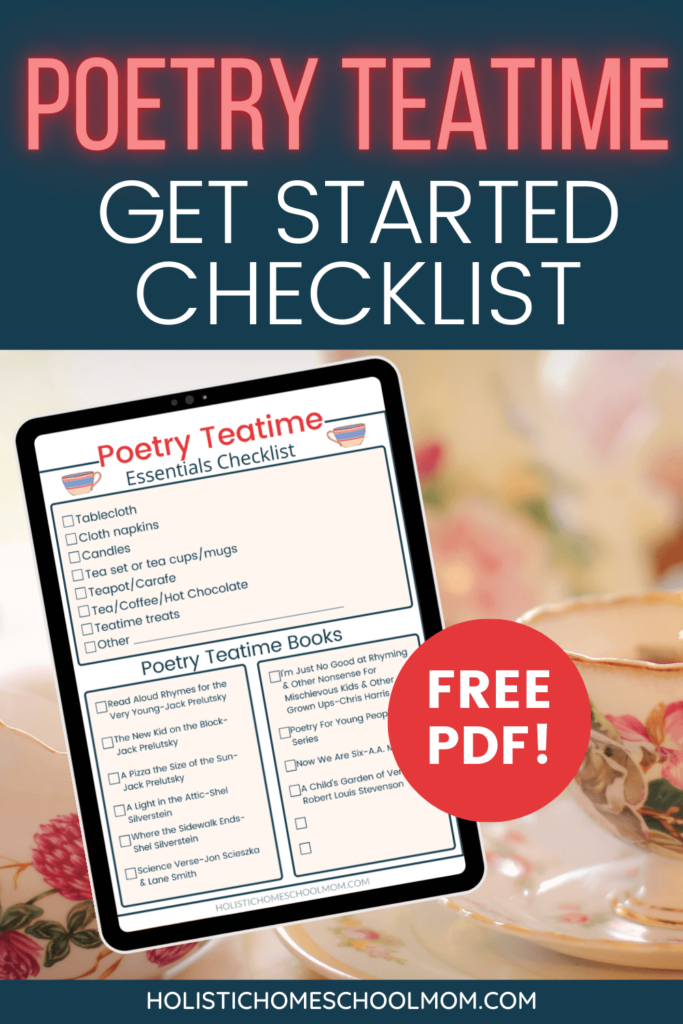
How Poetry Teatime Has Positively Influenced Our Homeschool
Our homeschool’s growth with poetry is most apparent when my 11 year old, who previously struggled to read poetry aloud, now reads his selected poems with a lovely cadence.
He also created a dedicated poetry journal that holds his own poem compositions, many of which are highly inspired by the likes of Shel Silverstein and Jack Prelutsky (excellent poets for boys, BTW!).
He gave me permission to share the first poem he was inspired to write, only a few weeks into our new habit of poetry teatime.
Autumn
When children are playing in wet autumn leaves,
And a cold autumn breeze is blowing,
And I am now knowing
It is going to be a perfect day.
When some go for a walk,
And some stay for a talk,
And the autumn days go by, I heave a sigh;
The first signs of winter come to.
Written by my youngest son, approximately 4th grade
5 Steps to Start Poetry Teatime In Your Homeschool
1-Keep Poetry Teatime Simple
Teatime doesn’t have to be a frilly tea party with dainty napkins and tea cups. I admit this is what I imagined when I first heard about poetry teatime. That sounded like a lot of work to me, and something my boys might not enjoy.
Do what makes sense for you in your current life space. Our poetry teatime is fairly plain and simple while still feeling special.
The essential items we use for poetry teatime in our homeschool include:
- a tablecloth
- a candle
- cloth napkins
- hot or cold drinks
- special treats
- great poetry books
Don’t underestimate the power of using special items like tablecloths and candles to create a unique atmosphere.
My sons (currently 11 and 14 years old) informed me that the set up of the table with all it’s accoutrements is one of their favorite things about poetry teatime, in addition to the poetry.
(They then proceeded to assure me, however, that they did enjoy the treats also, and would be lying if they pretended otherwise.)

2-Everyone Helps Set Up and Clean Up
When it’s time for poetry teatime, everyone contributes to getting things ready. One child brews the coffee (decaf of course) or heats water for tea, another sets the table with mugs, napkins, and treats, and another grabs the books.
3-Include Poetry Teatime On Your Homeschool Schedule
When writing out my middle schoolers’ assignment notebooks for the week, I make sure this activity is listed. Because the kids enjoy this time, they hold me accountable to ensuring it doesn’t get pushed to the wayside.
As homeschool parents, when we feel like we’re getting behind schedule, the tendency can be to scrap things we feel are non-essential (art, music, poetry, recitation, nature study, etc.).
Resist the urge to consider poetry teatime as non-essential (see Julie Bogart quote above again)!
With regular persistence in making this time happen each week, I believe you’ll see your children flourish, gain a love for poetry, and build positive relational capital with each other.
Especially during a day or week when the grumblings, grouching and bad-attitudes are overshadowing the good things, this time can be low pressure, low stress, and high joy.
4-Purchase Favorite Poetry Books
If your children are new to poetry or perhaps reluctant to poetry, I suggest starting with poetry books targeted for kids that have great pictures and incorporate plenty of humor.
I tend to mostly borrow books from the library, but with poetry teatime, I highly recommend purchasing the books your kids really love. This allows them to return to them again and again.
I’ll also confess we’ve experienced a few tea-spilling incidents in which library books were involved.
We bashfully informed the library of our unfortunate event, and then promptly decided having our own copies causes less stress for mom!
These are currently some of our favorite poetry books:
- Read-Aloud Rhymes for the Very Young selected by Jack Prelutsky
- The New Kid on the Block by Jack Prelutsky
- A Pizza the Size of the Sun by Jack Prelutsky
- A Light in the Attic by Shel Silverstein
- Where the Sidewalk Ends by Shel Silverstein
- Science Verse by Jon Scieszka & Lane Smith
- I’m Just No Good at Rhyming and Other Nonsense for Mischievous Kids and Immature Grown Ups by Chris Harris
- Now We Are Six by A.A. Milne
- A Child’s Garden of Verses by Robert Louis Stevenson (this links you to a free version at Gutenberg.org)
- Poetry for Young People Series
5-Have Fun Teatime Treats and Drinks
I try to reserve the special treats we have at poetry teatime as just that: special. It may be a special box of cookies from the store, but usually it’s homemade treats.
I can kill two birds with one stone when I combine baking as a lesson in math and home economics (is that still a thing?). We make double and triple batches, sample a few and freeze the rest.
Our favorite drinks include decaf coffee (usually with a healthy dose of creamer), fruity teas (like Celestial Seasonings fruit tea sampler), and hot chocolate.
Everyone has a favorite mug of their own (no fancy teacups here) that they’ve either received as a gift, or selected from the thrift store. (If you’ve never checked the thrift store for mugs, you’re missing out).
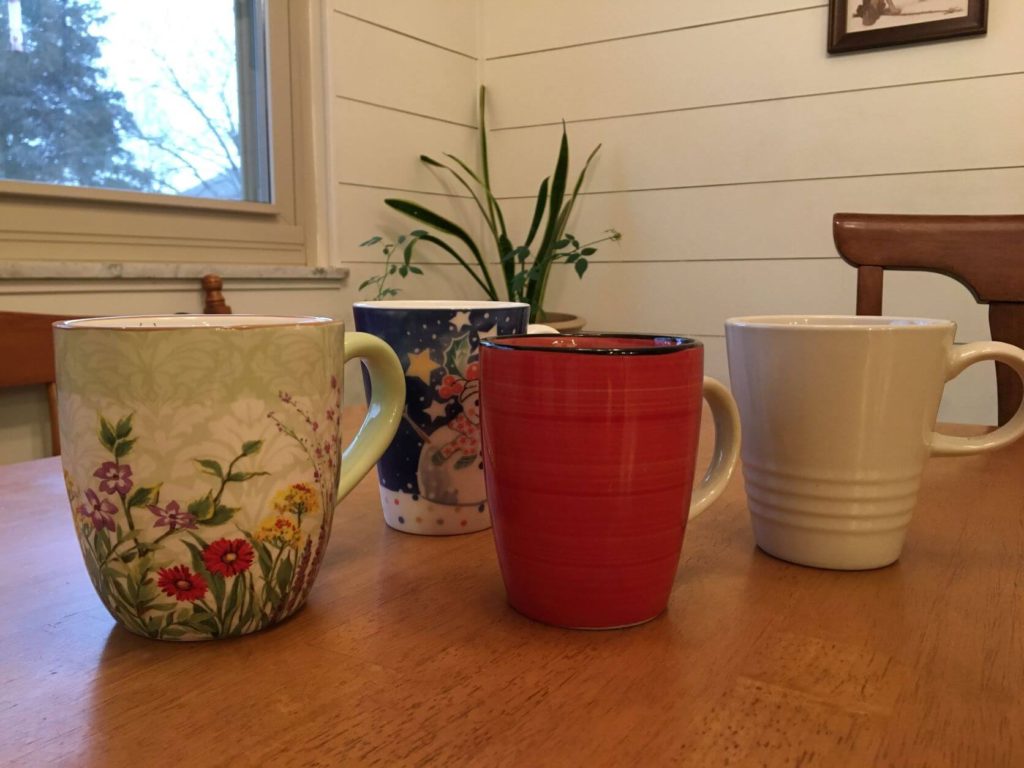
Include Poetry Recitation During Poetry Teatime
Are you familiar with the scene from the Anne of Green Gables movie where Anne is invited to give her recitation of the poem The Highwayman by Alfred Noyes?
What a great scene.
Not only does Anne look so lovely and grown-up, but she bravely rallies, despite her anxiety, to give a moving and theatrical recitation of the poem. She receives a standing ovation, even moving some of the audience to tears.
Poetry recitation is another practical and easy way to incorporate poetry into your homeschool. If you’ve not delved into the waters of recitation yet, it’s a fairly essential part of a Charlotte Mason-inspired education.
It’s also a built-in part of the free Ambleside Online curriculum that we used almost exclusively for our early elementary years.
Simply stated, recitation is memorizing a beautiful passage, scripture, speech, poem, etc., and reciting it for others.
It’s also an excellent way for your child to practice public speaking and exercise the mental muscle of memorization.
While my kids have only recited poems for our extended family during holiday get-togethers, the experience has been very valuable for them and highly enjoyed by the listeners.
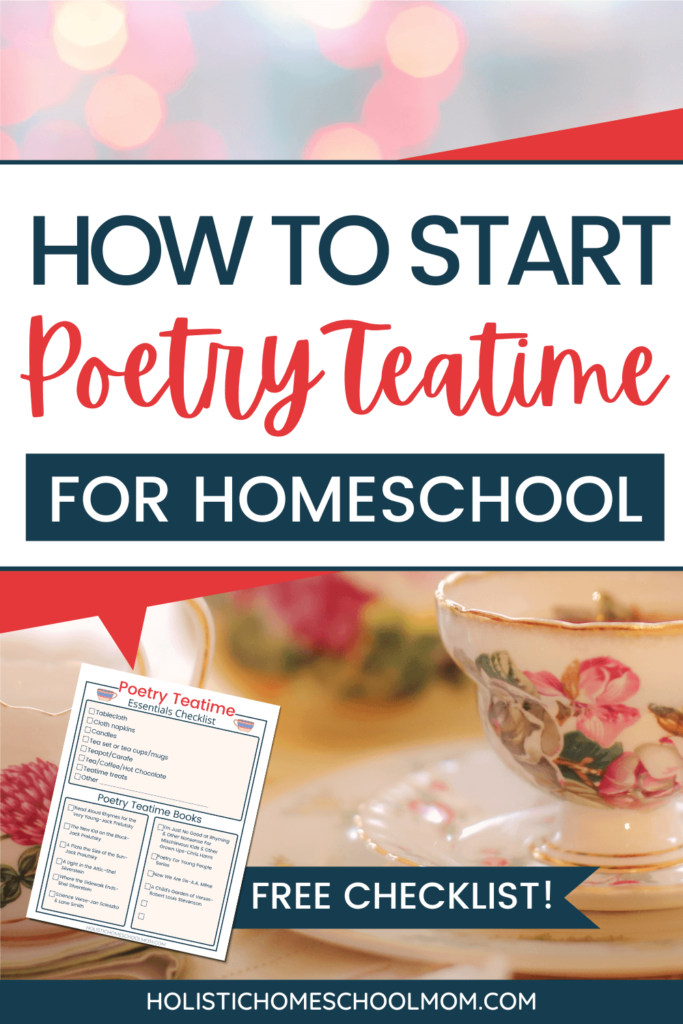
How We Include Poetry Recitation In Our Homeschool
Memorization work fits easily into our Morning Time routine. At the beginning of each school year, I partner with the kids to select a passage or poem for memorization and recitation.
We spend about 10-15 minutes a few days a week learning it line-by-line. They typically complete about two passages or poems each school year.
Start with small, simple poems for the youngest and increase to more challenging poems as your kids improve their memorization skills.
When my youngest daughter was just 3 years old she had completely memorized the poem Eighteen Flavors by Shel Silverstein. This was simply from hearing my youngest son practice memorizing it during our morning time.
Never underestimate what the youngest ones are absorbing during your group learning times!
Once your child has the work memorized, start focusing on basic public speaking skills, such as eye contact, posture, speaking clearly and enunciating.
With a little inspiration from Anne Shirley’s The Highwayman recitation, you can hone their recitation skills further by focusing on voice inflection, mood, and even dramatic gestures.
Excellent Poems for Poetry Recitation
These are poems we’ve memorized and are a great starting point:
- Eighteen Flavors-Shel Silverstein
- Stopping By Woods on a Snowy Evening-Robert Frost
- All Things Bright and Beautiful-Cecil Fances Alexander
- Out in the Fields with God-Elizabeth Barrett Browning
- Smart-Shel Silverstein
- The Arrow and the Song-Henry Wadsworth Longfellow
- Song-The Owl-Alfred Lord Tennyson
- Trees-Joyce Kilmer
- Eyeballs for Sale-Jack Prelutsky
- Christmas Bells-Henry Wadsworth Longfellow
- Crossing the Bar-Alfred Lord Tennyson
- Sick-Shel Silverstein
- Me Stew-Shel Silverstein
- Tree House-Shel Silverstein
Free Checklist to Help You Get Started with Poetry Teatime
Don’t wait to introduce poetry teatime into your homeschool like I did.
As a bonus to help you get started, I’ve created this simple Poetry Teatime Essentials Checklist. It includes basic essentials to consider, as well as book recommendations.
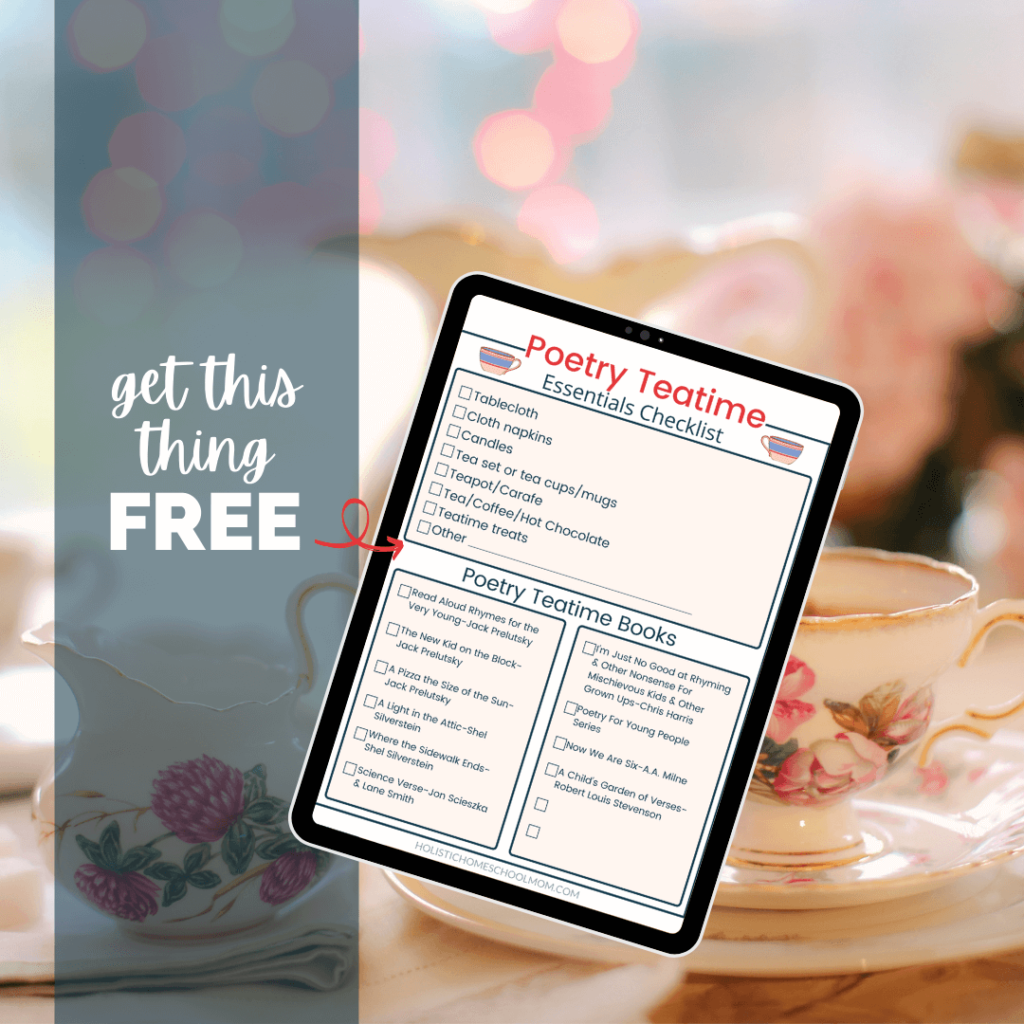
Print the checklist and take it to the thrift store to scavenge for affordable essentials like mugs, teapots, tablecloths, etc.
Then, pop into your library or local bookstore to grab those excellent poetry books.
For further poetry recommendations check out the list at Read Aloud Revival.
Additionally, you can find extensive information about poetry teatime from Brave Writer.
I hope you now feel equipped with helpful resources and tools to help you include poetry teatime in your homeschool. It’s a worthy endeavor to make space for poetry in your homeschool schedule. I believe you’ll find that it enriches your homeschool AND your relationship with your kids.



